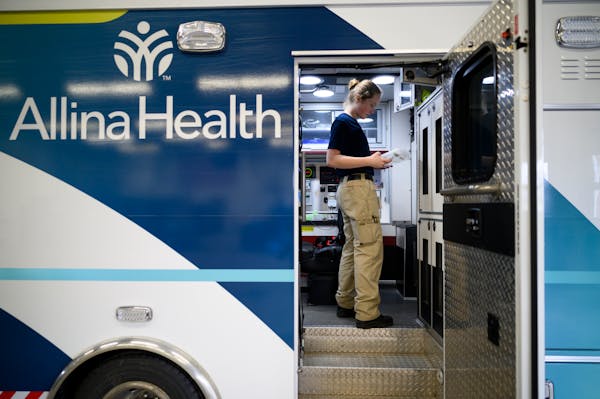A phone call telling Stephanie Beesing she was being cut off from her doctors and clinic was the last thing she wanted in month eight of a high-risk pregnancy.
Yet that happened last month, triggering a frantic effort to maintain access to her care through Glencoe Regional Health in Glencoe, Minn. The organization was taking the action because Beesing was far behind in paying $4,100 in medical bills.
"I love my doctors and nurses I work with," she said, "which is why this is frustrating."
Beesing's fight shows that the denial of care to patients with unpaid debts is a practice that goes beyond one health care system in Minnesota.
Allina Health's cutoff policy gained national attention in the New York Times earlier this month, prompting the Minneapolis-based health system to suspend it. Other providers have used it to confront increasing financial challenges. Glencoe is an independent provider in central Minnesota.
Beesing persuaded Glencoe to delay the loss of medical access until after her scheduled baby delivery on Thursday and at least two postnatal visits. After that, Glencoe will remain a resource for emergency care but not for clinical care for Beesing or her husband or newborn, she said.
"If I haven't paid the debt in full or set up an automatic withdrawal for $100 per month, then they are dismissing me from the clinic," she said. "I don't want to shirk the debt or anything. I'm willing to pay. I can't do $100 a month right now. I could do $20 to $30 a month."
Cutting off clinical access is a last resort used intermittently in Minnesota by providers such as Allina and HealthPartners. Kaiser Health News reviewed 500 U.S. health systems in 2022 and found 90, including Mayo Clinic in Rochester, that also used the practice.
Management of bad debt has always been a challenge, with Minnesota hospital providers writing off $473 million in 2020 when patients couldn't pay what they owed. The pressure to minimize that amount has increased, though, with hospitals reporting leaner finances following the COVID-19 pandemic.
Even before that event, 29 of 128 Minnesota hospitals were considered financially distressed, meaning they had lost money on operations in four recent years. Glencoe lost money on the operation of its hospital, clinics and other facilities in 2017, but has seen positive and improving margins every year through 2021, according to state data.
While Glencoe had written off debts that Beesing had accrued before her bankruptcy filing, it was unwilling to waive a new stack of bills resulting from her pregnancy and other medical needs. The health system said in a written statement that it encourages patients to seek financial assistance and reaches out frequently to discuss payment options before taking drastic measures.
"It is always our goal to avoid dismissal," the statement said. "We are an independent healthcare system here to serve our community — our patients are our friends and neighbors."
Beesing and her husband landed in bankruptcy two years ago through the combination of unexpected joblessness and costly chronic health problems. The couple had moved from Wisconsin and bought a house in Glencoe on the promise of a job that disappeared at the start of the COVID-19 pandemic.
"We ended up having to use credit cards and things like that," Beesing said. "It got out of hand and we couldn't keep up with it anymore."
It is a common refrain; one 2019 study estimated that medical debts factor into two-thirds of U.S. personal bankruptcies. Beesing's attorney, Margaret Henehan, said she has filed bankruptcy for an increasing number of clients to prevent them from losing access to their doctors.
"We know what to do with bankruptcy," she said. "So that ends the fight."
While bankruptcy protection set up a payment plan to help Beesing resolve old debts, it couldn't shield her from new bills when she became pregnant and required additional prenatal monitoring because of her diabetes.
Beesing, 35, works at a local library and her husband is in management training at a restaurant. They had a high-deductible health plan through the state's MNsure program, and qualified for a modest discount on premiums, but were still left with copays and out-of-pocket expenses that they couldn't afford.
The family is facing new pressures. Beesing wants to keep working to pay down the family's old and new debts, but child-care costs could exceed her salary. She is looking out of town for doctors, perhaps 20 miles away in Hutchinson or Waconia, but some aren't taking new patients or scheduling appointments anytime soon.
Beesing said many Glencoe officials have been sympathetic, and her doctor helped delay her loss of clinical access. She is hopeful of at least working out discounts to her debts. Meantime, the overdue notices keep coming.
"I actually just got another one today," she said.

Scene Makers Q+A: Rochester store owners head up Winona's Mid West Music Fest this weekend

Brooks: No funding, no lab, no problem for dogged University of Minnesota student inventors

Souhan: South Carolina's Staley brings humor, wisdom to St. Kate's
BCA says deputy stumbled and fell as man with knife charged in Chanhassen, prompting 2 deputies to shoot him

